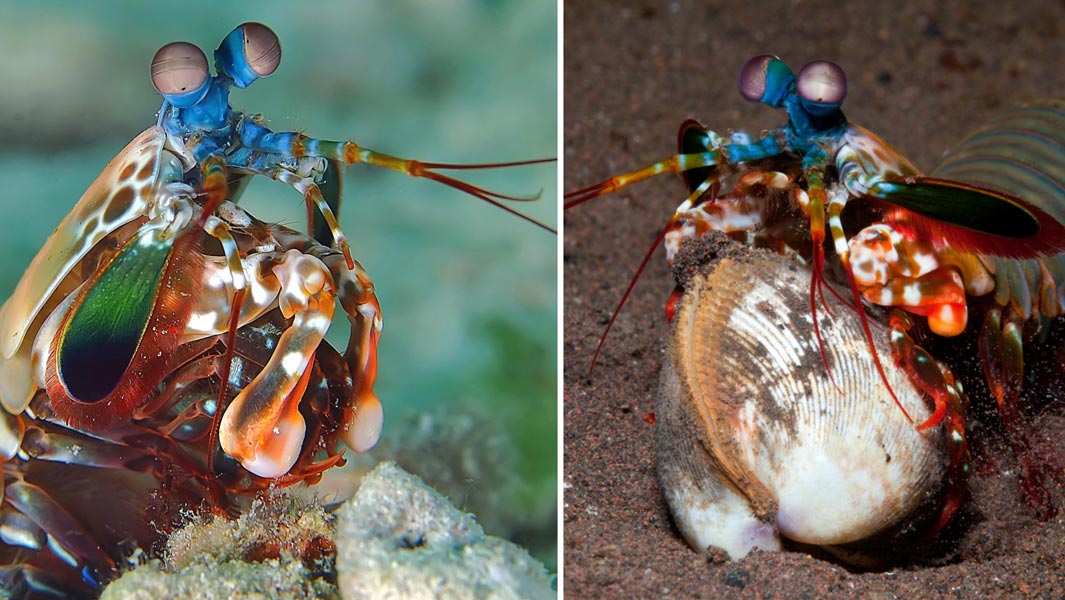The mantis shrimp packs the most powerful punch in the animal kingdom

Crabs, clams and other hard-bodied sea-life – be very afraid. Your shells can't save you now.
Despite its common name, the mantis shrimp is not actually a shrimp but a stomatopod, distantly related to lobsters and crabs. (And, admittedly, shrimps.)

Stomatopods are some of the most ancient animals on Earth, their evolution pre-dating the dawn of the dinosaurs by around 170 million years.
At first sight, the peacock mantis shrimp might not appear intimidating. Quite the reverse, in fact. Its shell is a stunning kaleidoscope of green, orange, blue and red (hence its common names, which also include "harlequin mantis shrimp" and "painted mantis shrimp"), while leopard-like spots adorn its legs

Native to coral reefs and other shallow-water habitats in the Pacific and Indian oceans, the species grows no more than 18 cm (7 in) long and weighs around 0.6 kg (1 lb 5 oz) – about as heavy as a basketball.

But it's a highly aggressive, territorial creature and doesn't take kindly to strangers invading the nooks and crevices that it calls home. Folded away beneath its body – much in the way that terrestrial praying mantises tuck their limbs beneath them – is a pair of lethal, club-like front legs, or "dactyls".
If threatened, the peacock mantis shrimp can whip out these appendages at speeds of 23 m/sec (75 ft/sec). That's 50 times faster than the blink of an eye, or about the same as the trajectory of a .22 calibre bullet – and with a force some 100 times that of its weight, making it the strongest self-powered strike by an animal.
It’s even been known to smash through glass…
Their potent attack armoury allows these crustaceans to prey on animals larger than themselves. Molluscs, crabs, shrimp and even other mantis shrimps are among their typical fare.
There are 400-plus species of mantis shrimp. Some, known as "spearers", have front legs topped with spear-like barbs with which they stab or snag soft-bellied prey, such as fish.
Others, like the peacock mantis shrimp, are "smashers", equipped with hammer-like clubs that they use to batter and bludgeon shellfish and crustaceans.
So rapid is the uncoiling of their deadly limbs that it generates vapour-filled bubbles between the limb and the animal it is about to hit. That effectively doubles the impact of the strike: after the club makes contact with its target, the bubbles collapse and unleash a shock wave that may stun or kill the prey (sometimes even if the blow misses altogether!).
How can this animal repeatedly deliver powerful blows without damaging itself in the process? The answer lies in the clubs’ complex structure. Lying beneath their thick outer "impact region" at the front is a composite of chitin fibres (a material that also makes up most of its shell). Stacked in helical layers resembling a spiral staircase, these act as shock absorbers, preventing any cracks from spreading through the club.

Researchers are now looking at ways in which the same principles could be applied to body armour, automobile frames and sports helmets.
There's more to mantis shrimps than just a knockout punch, though. Set at the end of stalks, their protruding eyes operate independently of each other, giving them an unusually broad visual field and particularly keen depth perception.

Whereas humans have three colour-receptive cones in our eyes sensitive to different wavelengths of light (red, green and blue), mantis shrimps have between 12 and 16, giving them the most sophisticated eyes in the animal kingdom.
Like flies, they have compound eyes, comprising thousands of tiny elements, each an independent light detector. They can see UV light and also polarized light – i.e., light that radiates in different directions. Excitingly, the mantis shrimp’s sensitivity to polarized light is now informing the development of cancer-detecting cameras.
Cancerous cells are easily detectable under this kind of light, as their chaotic structures scatter light waves in a different way to healthy cells. Researchers are now working on highly sensitive prototype imaging sensors that use polarized light to reveal cancer cells at a very early stage – even before they appear as visible tumours.
All of which makes the mantis shrimp a potential life-saver. Unless you’re a crab, that is…
Watch and read about more record-breaking animals in our Records Showcase
Header and thumbnail images: Shutterstock, Alamy


